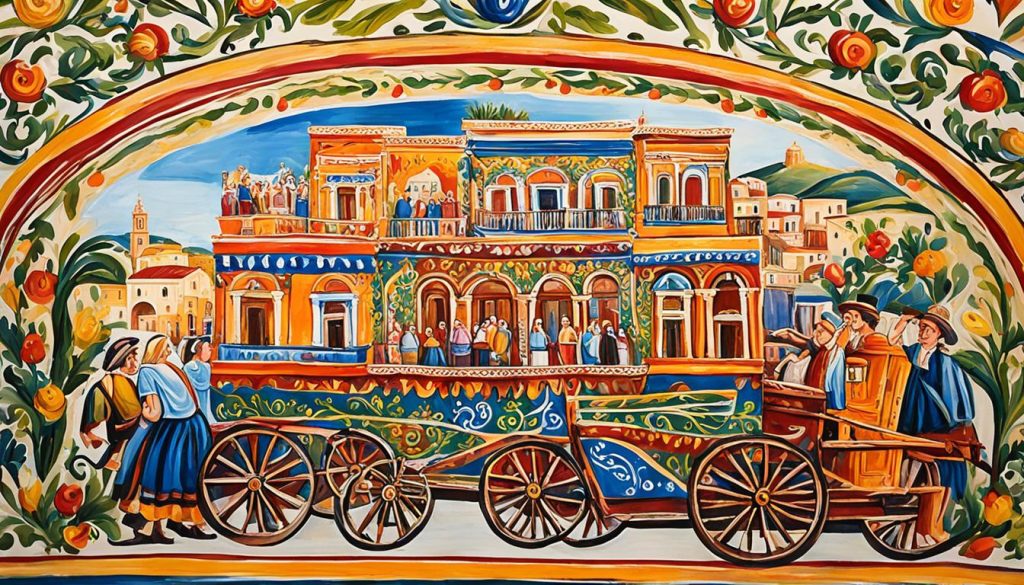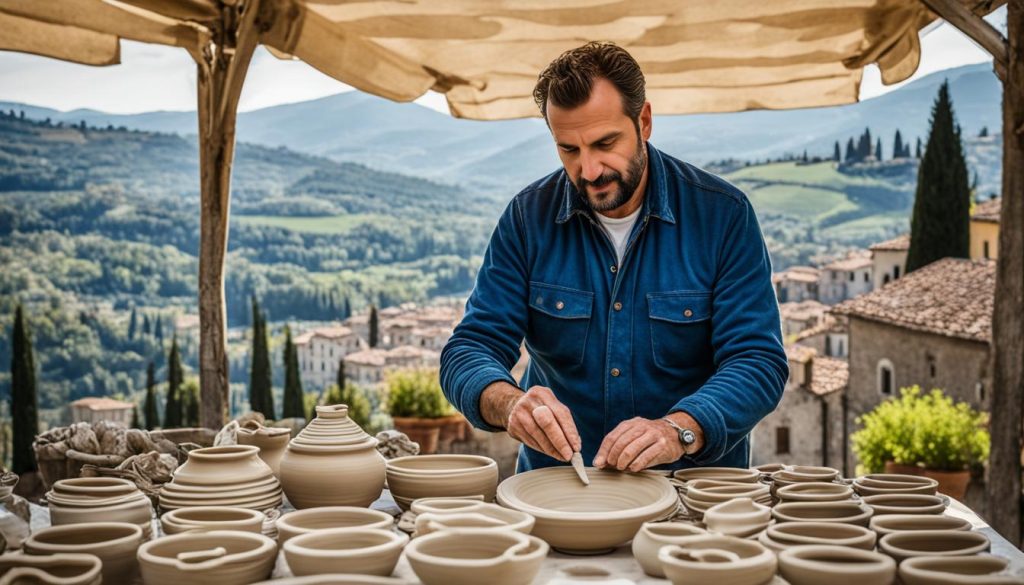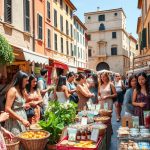We’re going to explore the deep heritage of Italian traditional crafts. From the ancient art of Venetian glassblowing to the detailed work of Tuscan leatherworking, these crafts have a timeless beauty. They are filled with Italy’s rich history and culture.
Italy is famous for its skilled artisans in various traditional crafts. These crafts have been handed down through generations. Each piece shows a legacy of skill and creativity. The detailed techniques and focus on every little thing make Italian traditional crafts very popular worldwide.
Key Takeaways
- Italian traditional crafts show off the country’s heritage and culture.
- Venetian glassblowing and Tuscan leatherworking are key crafts in Italy.
- These crafts are known for their detailed techniques and focus on details.
- They have been passed down through generations of skilled artisans.
- Italian traditional crafts are timeless and popular globally.
The Art of Venetian Glassblowing
Step into the enchanting world of Venetian glassblowing, a craft that has amazed people for centuries. It started in Venice, Italy, and is known for its beauty and skill. Master glassblowers turn molten glass into stunning art.
This craft is famous for its detailed designs and bright colors. Artisans use old and new techniques to make amazing results. They shape molten glass into different forms, like vases and chandeliers, on a blowpipe.
Venetian glassblowing is known for its bright colors like blue, red, and gold. These colors come from mixing minerals and metal oxides with the glass. Each piece is a unique work of art.
It’s not just about making individual pieces. Glassblowing Murano beads is also a big part of it. These beads are used in jewelry and are made with great care. Master beadmakers shape the molten glass into beautiful patterns.
The History and Legacy of Venetian Glassblowing
Venice has been making glass since the 13th century. This craft has made Venice famous around the world. People from everywhere admire and collect Venetian glass.
In the 15th and 16th centuries, Venetian glassblowers introduced new techniques. This made their glass even more popular in Europe. Artists like Angelo Barovier and Giuseppe Briati made the craft more sophisticated.
Today, Venetian glassblowing is still going strong. New artisans are keeping this tradition alive. Visitors can see how Venetian glass is made in workshops and studios in Venice.
The Enduring Beauty of Italian Glassblowing
Italian glassblowing is more than just Venetian glass. All over Italy, craftsmen make beautiful glass with their own styles. Each region has its own way of doing things.
From Murano’s delicate filigree to Empoli’s bold designs, Italian glassblowing is full of creativity. Each region adds its own touch to the craft, making Italy’s glassblowing scene diverse and vibrant.
The Craftsmanship of Italian Glassblowing
Understanding the skill and hard work behind Italian glassblowing is key. Master glassblowers spend years learning and practicing. They learn from experts and get better with time.
Making glass requires knowing a lot about glass and being precise. Artisans work fast and carefully. They balance heat and movement to shape the glass.
Italian glassblowing is a mix of art and love. Each piece shows the passion and tradition of Italian craftsmanship. It’s a remarkable example of human creativity and skill.
| Region | Distinct Style |
|---|---|
| Murano | Filigree work and vibrant colors |
| Empoli | Bold and vivid designs |
| Altare | Unique incalmo technique |
| Colle Val d’Elsa | Elegant and delicate glassware |
| Empoli | Bold and vivid designs |
Tuscan Leatherworking: Craftsmanship at its Finest
Explore the world of Tuscan leatherworking, where skilled artisans make beautiful leather goods. They use traditional methods passed down through generations. Tuscan leather is known for its top quality, detailed work, and timeless beauty. The art of making leather goods in Tuscany goes back centuries. It’s a place with some of the best Italian leather craftsmen.
The journey starts with picking the best raw materials. Tuscan craftsmen choose top-quality hides from local farms and tanneries. These leathers are strong and naturally beautiful, making the foundation of the artisans’ work.
In Tuscany, leatherworking combines old and new techniques. Artisans cut, shape, and stitch the leather by hand, focusing on every detail. They make everything from bags and wallets to belts and shoes with care and love.
Tuscan leatherworking is a big part of the region’s culture. Artisans in Tuscany are proud to keep traditional methods alive. This ensures each piece shows the old techniques that have made Italian leather famous worldwide.
Materials Used in Tuscan Leatherworking
Tuscany’s craftsmen use different leathers, each with its own look and purpose:
- Vachetta: A leather that gets a natural patina and ages well.
- Calfskin: Soft and smooth, calfskin is perfect for luxury bags and accessories.
- Exotic leathers: Tuscany also uses exotic leathers like python and ostrich, adding luxury and style to their work.
The Tools of Tuscan Leather Craftsmen
Tuscan leather craftsmen use special tools to make their work:
- Skiving knife: This knife thins and bevels leather edges for a smooth finish.
- Awl: A tool for making holes in leather for stitching.
- Mallet: A tool used to shape and align leather properly.
Tuscan leatherworking is more than a craft; it’s an art. The skill and dedication of the artisans show in every piece. Whether it’s a leather bag or shoes, Tuscan leatherwork shows the beauty and skill of Italian craftsmanship.
The Beauty of Florentine Paper Marbling

Discover the mesmerizing artistry of Florentine paper marbling. This traditional technique has captivated artisans and art lovers for centuries. It creates stunning designs with vibrant colors and intricate patterns.
Florentine paper marbling, known as ‘marmorizzazione della carta’ in Italian, started in Florence during the Renaissance. The skill needed to do this craft has been passed down through generations. This keeps the rich heritage of this tradition alive.
So, how does it work? It starts with a mix of water and special solutions. Skilled artisans then drop inks onto the surface. They use tools like combs or brushes to shape the pigments into patterns.
Each design is made with great care. The artisan guides the inks across the water. The pigments spread and mix, creating patterns that look like marble or other natural textures. Once the design is ready, a sheet of paper is placed on top to capture the ink patterns.
The paper is then lifted, showing off the beautiful marbled design. This marbled paper is great for many things, like bookbinding, stationery, and decorative arts. Its unique patterns and colors make it very popular among artists, collectors, and fans.
Today, Florentine paper marbling is still going strong. It shows how much people love this historic Italian craft. Whether it’s shown as art or used in projects, it adds beauty and craftsmanship to the world of Italian paper crafts.
A Glimpse into the Process
| Tool | Material | Significance |
|---|---|---|
| Brushes | Hog hair or feather | Used to drop inks and manipulate pigments on the water’s surface |
| Combs | Various sizes and patterns | Help create intricate patterns by combing through the pigments |
| Marbling Tray | Flat container filled with water | Serves as the platform for marbling process |
| Specialized Inks | Pigments suspended in water and thickening agent | Form the colorful patterns on the water’s surface |
| High-quality Paper | Variety of sizes and weights | Captures the marbled pattern when pressed onto the water |
The tools and materials for Florentine paper marbling are key to getting the right patterns and quality. Brushes and combs, made from natural materials, help control the pigments. The marbling tray, filled with water, is where the magic happens. Special inks, made with pigments and a thickener, create the beautiful patterns. Finally, using high-quality paper helps keep the marbled design looking great.
Explore Florentine paper marbling and dive into the beauty of Italian paper crafts. Let the intricate patterns and vibrant colors take you to a world of art and culture.
The Renaissance of Italian Pottery
Italian pottery has a long history, filled with traditional ceramic art. It ranges from delicate, hand-painted maiolica tiles to detailed vases. These pieces show Italy’s artistic skill and cultural heritage.
Deruta, in the heart of Umbria, is famous for its pottery. It’s known for vibrant colors, detailed designs, and careful craftsmanship. Artisans there use old techniques to make beautiful pieces loved by collectors everywhere.
In Campania, Vietri sul Mare is another key spot for pottery. Its ceramics reflect the Mediterranean with bright colors and coastal themes. Each piece is painted by hand, showing the area’s beautiful landscapes and sea culture.
Florence is also a big name in Italian pottery. Its ceramics are known for their complex designs and fine details. Florence’s artisans take inspiration from the city’s history, adding Renaissance art and architecture to their work.
A visit to Gubbio in Umbria is a must for pottery lovers. It’s known for its unique black and gold pottery, or “maiolica lustre.” This method involves high-temperature firing, giving the pottery a shiny finish that catches the light beautifully.
Italian pottery still amazes people all over the world. Its beauty, detail, and deep cultural roots make it a beloved art form. Whether it’s for decoration or daily use, Italian pottery adds elegance and tradition to any space.
| Region | Distinctive Features |
|---|---|
| Deruta, Umbria | Vibrant colors, intricate designs, traditional craftsmanship |
| Vietri sul Mare, Campania | Hand-painted coastal-inspired motifs, lively colors |
| Florence, Tuscany | Intricate designs, incorporation of Renaissance elements |
| Gubbio, Umbria | Maiolica lustre technique, black and gold pottery |
The Allure of Sicilian Puppetry
Dive into the magical world of Sicilian puppetry. Here, puppets tell stories that have been around for centuries. This form of Italian theater is rich in history and culture.
Starting in the 18th century, Opera dei Pupi combines storytelling, music, and visual arts. The puppets are made from wood and wear colorful costumes. Each one is a masterpiece.
The shows tell epic stories from medieval romances and historical events. They are based on the Sicilian heroic epic poem, the Chanson de Roland, and other old tales. The stories take you back in time with battles, sword fights, and good winning over evil.
Shows happen in special theaters called teatri dei pupi. Here, pupari move the puppets to life. Live musicians add music that makes the stories feel more real.
Sicilian puppetry is a big part of the local culture. It has been passed down for generations. Now, people are working to keep it alive for everyone to enjoy.
If you love theater, history, or just want to see something new, Sicilian puppetry is for you. The puppets, stories, and performances will leave you amazed.
Artistry of Sicilian Cart Painting

Dive into the magical world of Sicilian cart painting. This art form blends detailed designs with bright colours. It started in the early 19th century on Sicily and has become a key part of the region’s culture.
This art decorates wooden carts for transport and farming. Each cart is filled with hand-painted scenes and patterns. These show off Sicilian history, stories, and religious beliefs.
Artisans called “carrettiere” create these masterpieces. They use brushwork and stenciling for fine details. Their knowledge of colours and design makes each cart a piece of art.
The Symbolism of Sicilian Cart Painting
Sicilian cart painting is more than just pretty pictures. It tells stories from Greek myths, history, and religion. You might see scenes from the Siege of Troy or Hercules’ adventures on these carts.
The colours used in this art have deep meanings. Red stands for bravery, blue for protection, and gold for wealth. These colours make the carts stand out and show off Sicilian culture.
The Legacy of Sicilian Cart Painting
Even though carts are less used today, cart painting lives on as a tradition. Now, these carts are in museums and galleries for everyone to see. They let visitors see the beauty of Sicilian cart painting up close.
This art has gone beyond its original purpose. It’s now a symbol of Sicily’s artistic past. Its colours, designs, and stories have made it famous worldwide. It shows the creativity and spirit of the Sicilian people.
Discover the world of Sicilian cart painting. See the amazing skill that brings these carts to life. This art form lets you see the rich culture of Sicily in a unique way.
The Timeless Elegance of Venetian Mask Making
Discover the secrets of Venetian mask making, a craft filled with Venetian history and carnival traditions. These masks have amazed people for centuries with their detailed designs and mysterious charm.
Italian carnival masks are key to Venice’s vibrant and grand celebrations during the carnival season. They’re not just pretty faces but carry deep cultural meaning.
The craft of Venetian mask making goes back to the 13th century. It started with masquerade balls and carnivals in Venice. Initially, masks helped the Venetian nobility hide their identities among the common folk. Soon, they became a big part of the city’s carnival.
Artisans known as “maschereri” make each mask with skills passed down through generations. They start with a base of papier-mâché or clay. Then, they paint and decorate the masks with fine details and decorations.
Every mask has its own story through its design and symbols. From the classic “bauta” mask that covers the whole face to the fancy “moretta” worn by women, these masks bring mystery and intrigue.
During the Venice Carnival, people wear these masks to feel anonymous and free. It lets them be someone else for a short while.
The Symbolism of Venetian Carnival Masks
The masks are a feast for the eyes, full of colours, shapes, and materials. Each mask shows a different feeling and character. Here are some famous masks and what they mean:
| Mask | Meaning |
|---|---|
| Bauta | A symbol of anonymity and equality, worn by both men and women. |
| Medico Della Peste | Also known as the Plague Doctor mask, it represents protection and was worn during times of disease outbreaks. |
| Arlecchino | A jester mask symbolizing mischief, wit, and comic relief. |
| Pantalone | Depicting an old man, this mask represents greed and foolishness. |
| Colombina | Worn by women, it signifies beauty and grace. |
Venetian mask making is more than a craft; it’s a celebration of Venice’s rich culture. It captures the carnival spirit, letting people enjoy disguise and fun while connecting with the city’s history and traditions.
These masks enchant people all over the world, crossing time and borders. Whether they’re in a home or at a costume party, Venetian carnival masks bring glamour, intrigue, and timeless beauty.
The Fine Art of Italian Lace Making
Explore the world of Italian lace making, a craft known for its detailed patterns and careful work. Italy has a long history of making beautiful lace, and this tradition is still alive today. Let’s look into the artistry, techniques, and regional styles of this timeless craft.
History of Italian Lace Making
Italian lace making started in the 15th century with lace coming from the East. It became a luxury item. By the 17th century, Italy became a big lace producer, with lace workshops everywhere.
Venice became famous for its lace, known for its fine and complex designs. The lace makers, or merlettiere, used techniques like needle lace and bobbin lace to create beautiful pieces.
Techniques and Regional Variations
Italian lace making uses many techniques, each with its own style. The main techniques are:
- Needle Lace: This method uses a needle and thread to make lace. It lets makers create detailed and delicate patterns.
- Bobbin Lace: This technique uses a pillow and bobbins to weave threads. It makes lace with geometric designs.
Every region in Italy has its own lace making style, leading to many different patterns. For example:
- Burano Lace: From Burano island near Venice, this lace is famous for its bright colors and geometric shapes.
- Sansepolcro Lace: From Tuscany, this lace is known for its fine designs and often has floral patterns.
- Pizzelle Lace: From Abruzzo, this lace is known for its detailed geometric shapes and symmetrical patterns.
Preserving the Craft
Italian lace making is a highly valued craft, loved for its beauty and cultural importance. To keep it alive, groups and schools teach lace making all over Italy.
Today, Italian lace is still used in delicate clothes, accessories, and home decor. It shows the lasting impact of this fine craft.
Step into the world of Italian lace making, where tradition and art come together. See the beauty and skill of Italian lace up close. Appreciate the hard work and talent behind each piece.
The Craftsmanship of Neapolitan Nativity Scenes

Discover the magic of Neapolitan nativity scenes, a key part of Italian Christmas crafts. These detailed dioramas, or “presepi,” have been made with great care for centuries. Naples is the heart of this tradition, thanks to its deep cultural roots.
History and Symbolism
The story of Neapolitan nativity scenes starts in the 13th century with Saint Francis of Assisi. He created the first live nativity scene in Italy, which quickly became popular. In Naples, artisans began making detailed nativity scenes with tiny figures and complex settings.
These scenes show not just the nativity but also the lively streets of Naples. They feature a wide range of figures, like the Holy Family, shepherds, and everyday people. Each figure is made by hand, wearing detailed clothes and painted to look real.
Expert Craftsmanship
Creating a Neapolitan nativity scene needs the skill of “presepiari,” the craftsmen and women. They spend a lot of time sculpting, painting, and putting the scene together. Every little detail, from the faces to the fabrics, is given a lot of thought.
Wood, terracotta, and papier-mâché are the main materials for these scenes. Each figure is carved by hand, making each one unique. The artisans then paint them with bright colors, bringing the scene to life.
What makes these scenes special is the detailed scenery. The backgrounds are made to look like the Italian countryside, with moss, rocks, and more. The tiny buildings are designed and painted to look like Naples’ architecture, adding realism.
An Enduring Tradition
The tradition of Neapolitan nativity scenes is still going strong in Naples and is loved worldwide. These beautiful scenes can be seen in homes, churches, and public places during Christmas. They tell the story of the religious holiday with great beauty.
Now, people all over the world are keeping this tradition alive. The love for making these scenes ensures that they will continue to amaze people for years to come.
| Key Features | Materials Used |
|---|---|
| Intricate figurines | Wood |
| Lifelike scenery | Terracotta |
| Detailed miniature buildings | Papier-mâché |
Ligurian Shipbuilding: Tradition on the Sea
Explore the world of Ligurian shipbuilding, a craft steeped in Italy’s maritime history. Liguria is famous for its stunning coast and seafaring traditions. For centuries, shipbuilders here have crafted vessels that reflect the region’s seafaring spirit and commitment to quality.
Every step in Ligurian shipbuilding is done with great care. From picking the best materials to using old techniques, these craftsmen make boats that are both useful and beautiful. Their work shows a deep respect for Liguria’s maritime past.
Techniques and Tools
Ligurian shipbuilders use a variety of techniques to make their boats strong and look great. They focus on hull building, planking, caulking, and finishing. Each step is done with a mix of old and new methods for the best results.
The tools they use are just as varied. From hand tools like wooden mallets to modern power tools, each one is chosen for its precision. This careful selection is key to making boats that meet Ligurian standards.
The Cultural Significance
Ligurian shipbuilding is more than just building boats. It’s a big part of the region’s culture, linking it to its maritime history. These boats have been important for transportation, fishing, and even showing wealth and prosperity.
It’s also a source of pride for local communities. It reminds them of their resilience, creativity, and commitment to tradition. The boats tell stories of generations past, making them more than just objects.
Today, Ligurian shipbuilding is still going strong, with new generations learning the craft. The beauty of traditional boat making and Liguria’s coast ensures these vessels will keep sailing. They’ll keep the region’s maritime heritage alive for many years.
The Craftsmanship of Venetian Gondolas
Explore the world of Venetian gondolas, elegant boats with a deep connection to Venetian culture. These boats are famous for their unique design and craftsmanship. They have become a symbol of Venice, loved by locals and visitors.
The art of building Venetian gondolas has a rich history. It has been passed down through generations of skilled craftsmen. This tradition keeps the gondola’s legacy alive.
Gondola Construction: A Work of Art
Building a Venetian gondola is a detailed process. It requires a lot of care and precision. The gondola is made from eight different types of wood. These woods are chosen for their strength, flexibility, and durability.
The shape and design of the gondola are carefully crafted for balance. This balance lets the boat move smoothly through Venice’s narrow canals. The gondola’s unique asymmetrical hull shows the skill of the builders.
The finishing touches on a gondola are impressive. They feature beautiful decorations and a velvet interior. The gondola’s iron prong, or “ferro,” is both a decoration and a counterweight for the gondolier.
The Importance of Gondolas in Venetian Culture
Gondolas are very important in Venetian culture. They used to be the main way to get around Venice. Now, they are symbols of the city’s beauty and romance.
Even though gondolas are not used for transport much anymore, they are still a big part of Venice’s tourism. Visitors can enjoy a ride on a gondola through Venice’s canals. A skilled gondolier will guide them through the waterways.
Today’s boat builders in Venice respect the tradition of gondola making. They work hard to keep the traditional techniques alive. Their efforts ensure that gondola making will continue for many years.
A Glimpse of Venetian Gondolas
| Gondola Facts | |
|---|---|
| Length | Around 11 meters |
| Weight | Approximately 600 kilograms |
| Gondoliers | Skilled and licensed boatmen |
| Production Time | Months of meticulous craftsmanship |
| Unique Features | Asymmetrical hull and ornate decorations |
Continuing the Legacy of Italian Traditional Crafts
We look back at the lasting impact of Italian traditional crafts. Venetian glassblowing and mask making show the beauty of Italy’s culture. It’s vital to keep these crafts alive so future generations can enjoy their beauty and skill.
Artisans in Italy have spent their lives mastering their crafts. They pass their skills down through generations. Groups and communities work hard to keep these crafts alive. They do this through workshops, shows, and learning programs.
This work helps bring new artisans into the field. It ensures these crafts keep going.
Italian traditional crafts make us proud and show our creativity and skill. By keeping these crafts alive, we pay tribute to our ancestors. They tell stories and link us to our roots. Let’s keep supporting these crafts. They are a treasure for the future.
















